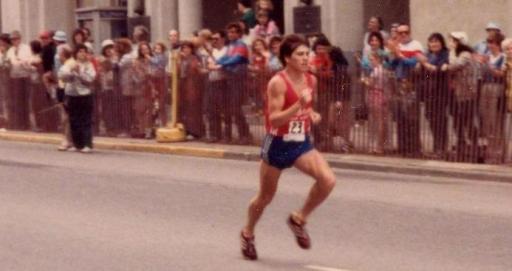The tree, which is a large White Oak, has stood the test of time and is known by every athlete that has been through a sports program here at the University of Richmond over the past 60 years at least. It provides our athletes a spot of shade during the August and September heat but our track athletes know it for the acorns that drop each fall onto the track surface. We’ve even had our share of acorn fights following practices…not that a coach would start something like that.
As I read the article I remembered a photo Allen Saville (UR ’67) sent to us prior to our 2009 UR Track & Field Alumni Reunion. You will find the photo below…It shows a member of Coach Fred Hardy’s Richmond Team long jumping under that same White Oak Tree. The photo is a classic and was taken in 1967 prior to the Robins Center (location of our basketball arena and coaches offices) construction of 1972.
The Oak Tree as it stood 43 years ago in 1967
before the Robins Center was built in 1972
Notice the landing area for the Long Jump...
and the High Jump (background) (Allen Saville photo)
Tree is fixture even before Robins Stadium opening
Published: May 11, 2010
Frank Pajaczkowski can still hear Fred Hardy yelling.
"Grab that tree!"
Pajaczkowski was a long jumper for coach Hardy's 1952 University of Richmond track and field team. High above the long jump landing pit were the branches of an old tree, rooted near the cinder track. Hardy wanted his jumpers to reach for the limbs, achieving extension that would maximize results.
Charlie Cloe played baseball at UR during the early 1960s and recalls the tree being directly behind home plate. Foul pops that hit the branches were dead balls, per ground rules. Chuck Boone, a star catcher for the Spiders who later went on to become the school's baseball coach and athletic director, recalls the tree frequently coming into play.
"The umpire would say 'It hit a branch,' and I'd always say 'It didn't hit a branch,' especially if I caught it," Boone said.
UR's football program practiced for generations at the site, adjacent to where the Robins Center now stands, and Spiders football returned its practice operation to that venue several years ago. Soccer was played there, and women's lacrosse. The tree watched it all.
Seven years ago tomorrow, UR's Board of Trustees announced that the school would build an on-campus stadium to accommodate football. Soon after, the tree was identified as a landmark worth saving by the school. Construction crews worked gently around it.
"We place a huge value on preserving any trees we can," said John Hoogakker, associate vice president for facilities at UR. "In this case, we just thought that having a spot of green and having a shady oasis right inside the front gate just made a nice statement about the way the university tries to balance the built environment with the natural environment."
He added that former UR athletes expressed an interest in seeing the tree stand in the southwest corner of the stadium as a link from past to present Spiders.
"I'm sure most people could care less about it. It doesn't mean anything. But when I think of playing baseball up there on that field, I always remember the tree," said Cloe, who graduated from UR in 1964. Another Spiders baseball facility, Pitt Field, opened during the early 1970s near the lake that bisects campus.
A UR tree inventory done a few years ago determined that that the mighty tree in Robins Stadium "is probably the oldest specimen, and definitely the largest specimen at the base, of any tree on campus," said Hoogakker. "It's kind of the grandfather of all the other trees on campus."
Since construction began on Robins Stadium, a tree surgeon visited the tree on numerous occasions, including after it was hit by lightning. The tree surgeon cut some roots that needed to be removed in order to make room for necessary digging. Still, there was fear among supporters of the tree that all of the construction around it would lead to deadly trauma.
"That was one of the big things about doing this job, and that came right up front, that we had to save the tree," said Bob Boatwright, senior superintendent for Hourigan Construction, builder of Robins Stadium. "Whatever it took to save the tree, we had to make sure we followed the right protocol to achieve that."
Boatwright estimates the tree's age at "100-plus."
The tree grew new leaves this spring and appears to be in fine shape to survive another summer. The Spiders open Robins Stadium on Sept. 18 vs. Elon.
________________________________________
RTD Article Contact John O'Connor at (804) 649-6233 or jcoonnor@timesdispatch.com






No comments:
Post a Comment